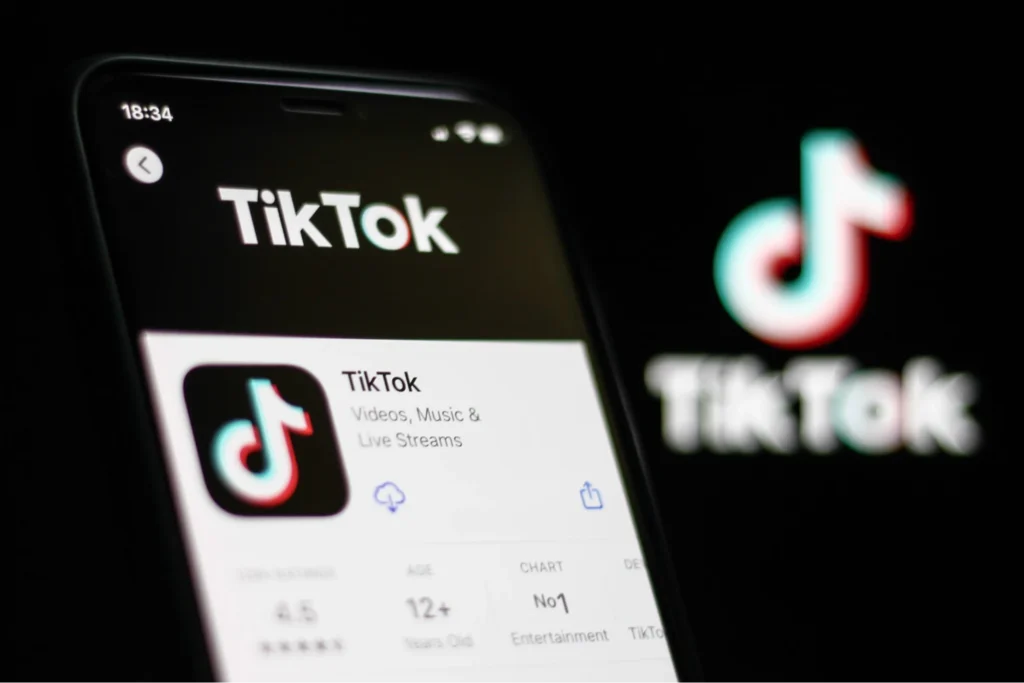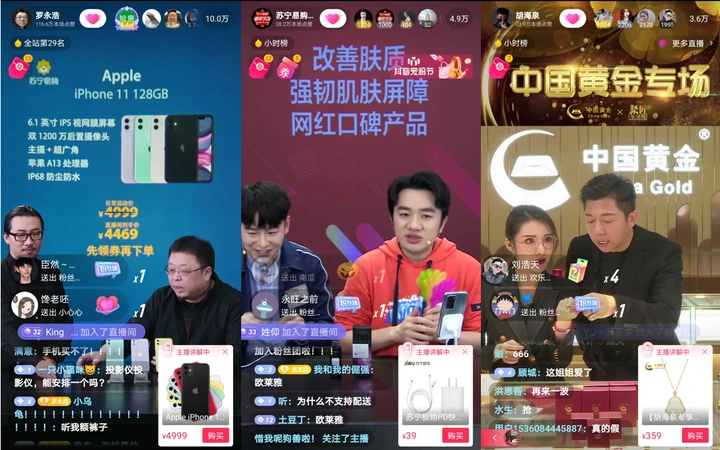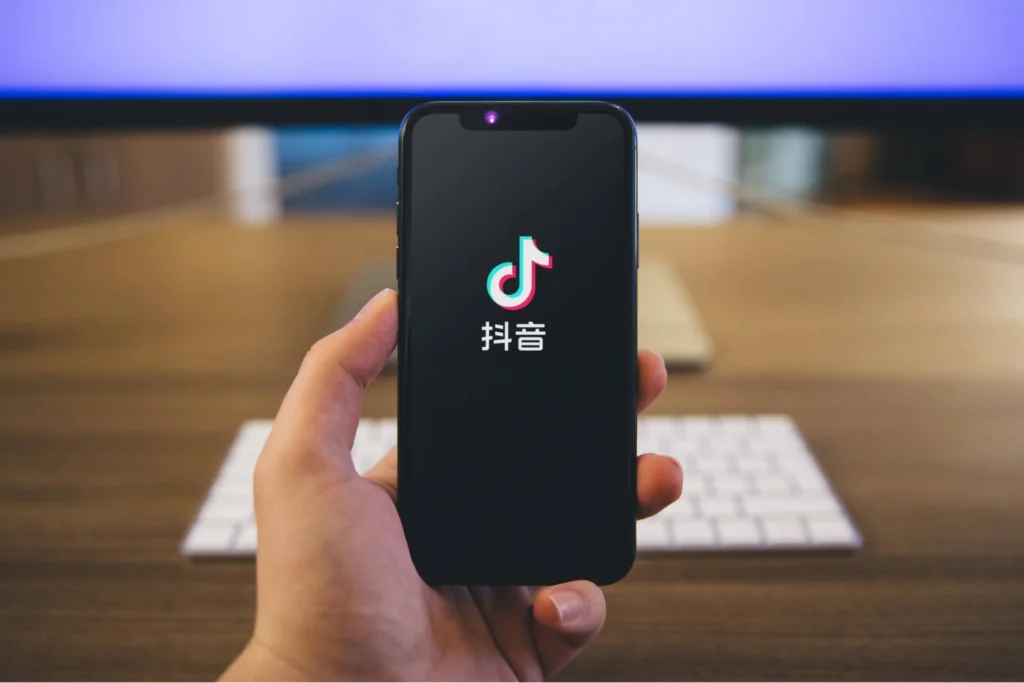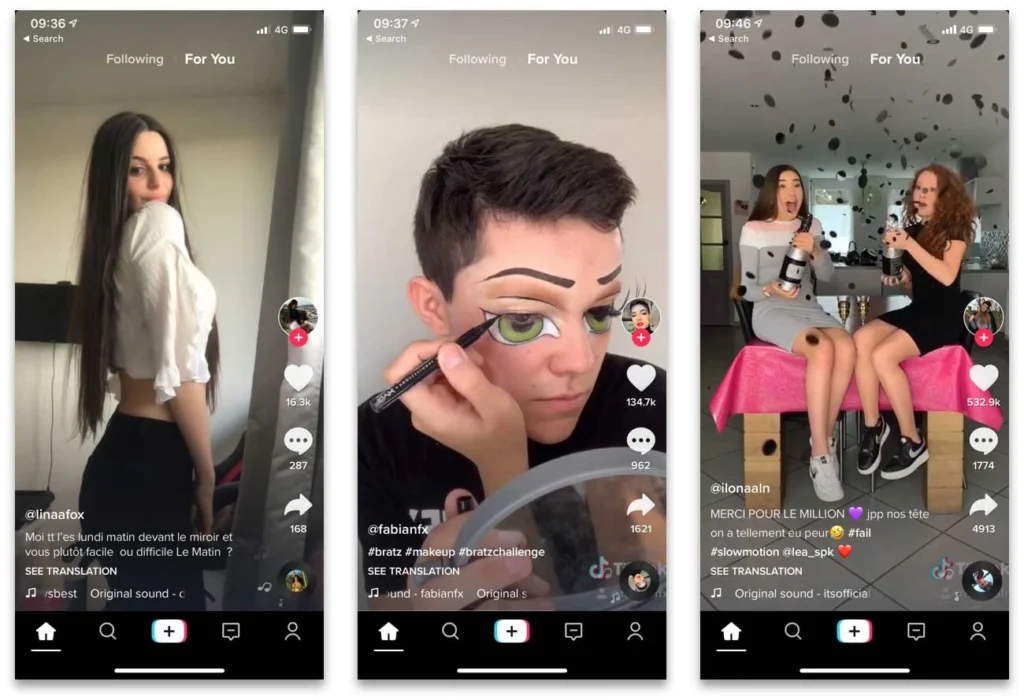In 2025, the rise of ByteDance had positioned the company as a global powerhouse beyond TikTok. Its dominance rests on three growth engines: Douyin’s ecosystem in China, TikTok’s international commerce push, and its Volcengine/Doubao AI platform.
TikTok drives ByteDance’s global expansion, with TikTok Shop reshaping how consumers in Southeast Asia, the U.S., and Europe discover and purchase products. Subsidies and logistics partnerships fuel this rapid growth despite mounting regulatory scrutiny.
Meanwhile, Volcengine and Doubao anchor ByteDance’s AI ambitions. By mid-2025, they commanded nearly half of China’s LLM public-cloud market. Together, these three pillars define ByteDance’s rise in 2025: an attention, commerce, and AI operator navigating intense competition and political risk.
Where ByteDance Makes Its Money in 2025

Ads: Douyin (China) vs TikTok (International)
Advertising remains ByteDance’s core revenue stream.
In China, Douyin dominates digital budgets. It integrates ad placements with e-commerce data and local services, giving brands measurable conversion rates. While revenue growth slowed in 2024, ByteDance remains the leading player in China’s ad market by scale. Competition from Alibaba and Kuaishou adds pressure, but Douyin’s targeting precision keeps it ahead.
Internationally, TikTok continues strong ad growth. Formats like Spark Ads and shoppable creatives link influencers directly to transactions. In 2024, TikTok’s ad revenue reached an estimated $39 billion, pulling spend from Meta and YouTube in key markets.
Its pricing and reach attract global brands and SMEs alike, though regulatory scrutiny in the U.S. and EU poses risk.
Commerce: Douyin E-commerce + TikTok Shop
E-commerce is ByteDance’s second engine, closely tied to its content platforms. Douyin E-commerce reached about ¥3.5 trillion GMV in 2024, up 30% year-on-year. Growth now comes from three channels:
- Shelf commerce: Stable listings beyond live streams.
- Live commerce: Still large, but growth is slowing.
- Local services: Food delivery, travel, and vouchers deepen user reliance.
TikTok Shop expands the model abroad. In Southeast Asia, it is mainstream; in the U.S. and Europe, it is gaining momentum rapidly. Influencer storefronts and subsidies fuel adoption, with beauty, fashion, and electronics as leading categories. Logistics partnerships reduce friction, but subsidies compress margins. ByteDance accepts this because global scale is the priority.
AI & Infrastructure Monetization
ByteDance now monetizes AI infrastructure alongside consumer apps.
- Volcengine leads China’s LLM public-cloud market, with nearly 49% share in token calls in mid-2025. Enterprises use their APIs for search, customer service, and recommendations.
- Doubao drives daily token growth. It supports assistants in Douyin and TikTok, enterprise copilots in retail and education, and ad-creative generation pipelines.
- Seedream 4.0, ByteDance’s multimodal model, powers video editing tools and enterprise offerings. It strengthens internal content supply and reduces CPM costs.
Monetization comes through API calls, SaaS contracts, and enterprise solutions. Margins remain thin due to heavy infrastructure spending. ByteDance invested about $8 billion in servers in 2024, ranking among the world’s top five buyers.
This AI stack defends ByteDance’s consumer ecosystem and establishes a new enterprise revenue stream, diversifying beyond advertising.
TikTok: The Engine Behind ByteDance’s Rise

ByteDance’s dominance in social media is primarily attributed to TikTok’s explosive global growth. It’s short, addictive, algorithm-powered video feed caught fire with younger audiences worldwide, pushing competitors like Instagram and YouTube to copy the format. By early 2024, TikTok had become one of the most downloaded and fastest-growing apps globally.
A Global User Surge
By April 2024, TikTok had racked up 4.92 billion downloads and reached 1.58 billion monthly active users, ranking it fifth globally. And it’s not slowing down—some projections suggest the platform could top 2.25 billion users by 2027.
In 2025, approximately half of all Americans in the U.S. are using TikTok. That kind of reach has turned ByteDance into a central player in how people connect, consume, and create media.
How ByteDance Reimagined Social Media
Unlike traditional social platforms like Facebook or WeChat, which revolve around friend networks, TikTok and Douyin (its Chinese counterpart) use advanced AI algorithms to deliver content based on what you like—not who you know. That content-first, discovery-driven model is key to ByteDance’s secret sauce.
The Power of the Algorithm
Analysts often cite ByteDance’s algorithm as the backbone of TikTok. It quickly identifies trends and delivers hyper-personalized content in real-time—memes, dance crazes, viral challenges, and more. This reshaped social media into a more immersive, entertainment-first experience, where communities form around shared interests rather than existing connections.
Doubling Down on AI and Creativity
ByteDance isn’t just leading in content delivery—it’s pushing the envelope in content creation too. In early 2025, the company’s Seed lab launched Seedream 4.0, a cutting-edge AI model that can generate or edit images from text prompts—fast and in 4K quality. These tools help creators unlock new ways to make standout content on TikTok and Douyin.
The App Factory Strategy
Beyond visuals, ByteDance has been flooding the market with AI-driven apps: chatbots, music generators, video editors—you name it. This “app factory” model shows ByteDance’s ambition to weave AI into every product experience. The result? Even smarter TikTok feeds and ever-more powerful creative tools that keep users engaged.
From Challenger to Global Tech Giant
With 2023 revenue nearing $120 billion and user growth outpacing giants like Meta, ByteDance is increasingly seen as the leader of China’s internet scene. Its influence extends beyond just one app, shaping the future of digital interaction worldwide through short-form content, live streams, virtual gifts, and algorithmic personalization.
Douyin and the Transformation of Commerce in China

Within China, ByteDance’s Douyin has completely reshaped how people shop. What started as a short video app evolved into a massive e-commerce machine. By late 2024, Douyin had 300 million daily active users—about a quarter of China’s population—and a seamless content-to-commerce pipeline.
According to official figures, Douyin’s commerce platforms saw 3 trillion RMB (around $420 billion) in sales by the end of 2024, with over 58% of that coming from live-stream shopping alone. That means more than half of those transactions happened during live shows—a scale no one would’ve predicted just a few years ago.
Content Meets Commerce—And Becomes Infrastructure
Douyin led the charge in merging content and shopping. It’s no longer just about grabbing attention with videos; it’s a full-blown retail system. Influencers and brands create content, Douyin’s algorithm serves it to the right viewers, and users can shop instantly via one-click purchases or livestream orders.
Chinese analysts now view Douyin as more than a trend—it has become a core retail infrastructure. For many brands, it’s not just an ad platform. It’s where they build their identity, connect with customers, and test new products. One industry report aptly stated: Douyin commerce has transitioned from “phenomenon” to “foundation.”
A New Era of Professional Live Commerce
In 2025, Douyin’s leadership rolled out new goals: they’re pushing to grow sales from product catalogs (static store pages) and “shop broadcasts”—live streams hosted by brands or stores themselves. A ByteDance-backed report projected that by the end of 2025, shop broadcasts would account for over 30% of sales, and product catalogs for 40%.
In fact, the shift is already happening. In 2024, 41% of Douyin’s live-commerce sales came from brand-run streams, beating the 38% from influencer-led ones. Thousands of stores jumped in: by mid-2025, over 162,000 Chinese shops had passed 1 million RMB ($137,000 USD) in Douyin livestream sales—a 113% increase year-over-year. This signals a move from influencer-heavy promotion to a more scalable, store-first model.
ByteDance is actively fueling this growth. In early 2025, Douyin e-commerce introduced new merchant-friendly policies, including subsidies, free services, and enhanced logistics support. They also rolled out tech upgrades, including QR code product links in videos, in-app payments, virtual try-ons using AR/VR, and even AI co-hosts for live shows. A January 2025 announcement detailed tools to help small businesses succeed, including fee waivers and improved search rankings.
Social Commerce That Reaches Everyone
Shopping on Douyin is now part of everyday life—whether it’s for daily necessities or high-end goods. Thanks to the platform’s reach and recommendation engine, even small-town sellers and rural farmers can connect with buyers nationwide. Chinese media have even credited Douyin’s platform with helping alleviate poverty by giving these communities direct access to the market.
In short, Douyin has turned social media into a retail powerhouse. Discovery, entertainment, and shopping are all rolled into one. In 2025, the old boundaries between content and commerce will have disappeared. One Chinese analyst summed it up perfectly: “Content is the channel, interaction is conversion.” Douyin has made e-commerce in China more dynamic, interactive, and accessible than ever before.
TikTok Shop and the Global Social Commerce Push

ByteDance didn’t stop with Douyin’s success in China—it took the model global. Building on TikTok’s massive reach, the company launched TikTok Shop, a social-commerce platform that enables users to purchase products directly from videos and livestreams within the app. After proving the model worked in China, ByteDance rolled it out internationally, first testing it in the UK in 2021 and then officially launching it in the U.S. in late 2023.
The results came fast. TikTok Shop’s global GMV (gross merchandise value) skyrocketed from $1 billion in 2021 to $33 billion by 2024—a 33x jump in just three years. According to Chinese industry reports, this made TikTok one of the fastest-growing retail platforms globally.
Regional Ups and Downs: U.S. vs. Southeast Asia
But not every market took off the same way. The U.S. fell short of ByteDance’s expectations in 2024, generating just $8.5 billion in GMV—far below the target of $15.5 billion. That led the company to revise its 2025 goal down from $25 billion to $18 billion. Analysts attributed the slowdown to political uncertainty and internal restructuring in the U.S.
Meanwhile, Southeast Asia exploded. TikTok Shop brought in $34 billion GMV in the region in 2024, with projections hitting over $65 billion for 2025. ByteDance leaned into that momentum—offering seller subsidies (up to 22% off), streamlining logistics to 4-day delivery, and ramping up local hiring. The result? TikTok Shop’s share of Southeast Asia’s e-commerce doubled in a year, from 8% to 16%.
Expanding Across Europe and Japan
ByteDance didn’t stop there. In March 2025, TikTok Shop launched in France, Germany, and Italy, expanding its presence to these countries following its initial launch in the UK. Big names like Carrefour, About You, and Cosnova cosmetics jumped on board early. Soon after, ByteDance began prepping for a Japan launch, actively recruiting local sellers.
These moves demonstrate ByteDance’s seriousness about making TikTok Shop a global retail platform—not just a phenomenon in China or the U.S.
How TikTok Shop Works
TikTok Shop blurs the lines between entertainment and shopping. Videos and live streams double as storefronts, allowing users to tap product tags in short clips or join live shopping events hosted by influencers or brand representatives. Many items come with deep discounts, and TikTok earns a cut from each sale.
It’s not just traditional retail either—ByteDance has experimented with virtual storefronts, auctions, and even luxury resale. One standout case: a London retailer sold a second-hand Hermès Birkin bag on TikTok Shop. The platform is also rolling out features like in-video storefronts, affiliate commissions, and AI-powered product recommendations, all designed to turn content into commerce.
The Bigger Picture: A New Retail Model
By 2024, TikTok Shop had become the second-fastest-growing e-commerce channel in the world. U.S. GMV alone jumped 650% to hit $9 billion. Across all markets, TikTok Shop is now a significant retail force—especially among Gen Z and millennials.
There’s still a ton of upside: nearly half of major Western brands aren’t active on TikTok yet. Analysts predict that as more companies join the platform, TikTok’s ad and commerce revenues could surge even higher.
By merging content and commerce so tightly, ByteDance didn’t just create a new feature—it pioneered a whole new way to shop online. Other platforms are already racing to catch up.
Challenges and Strategy: Navigating 2025

ByteDance faced significant geopolitical challenges in 2025, particularly in the U.S., where a 2024 law mandated the divestment of TikTok’s American operations by January 2025.
In response, the company reengaged with U.S. stakeholders, working with investors to restructure TikTok’s U.S. presence. By late 2025, a framework agreement was reportedly in place to create a U.S.-controlled entity for managing American user data.
ByteDance also emphasized compliance with Chinese law in any separation process. To ease regulatory concerns, it began isolating TikTok’s U.S. data and content systems from its global operations.
Strategy Shifts and Financial Growth
Operationally, ByteDance restructured in 2024 into six core divisions: Douyin, TikTok, Dali Education, Feishu (Lark), Volcano Engine, and gaming. It exited underperforming units—selling its gaming division to Tencent in 2023 and downsizing Feishu in 2024.
The company follows a “test and cut” model—pushing new ideas but dropping those that underperform. This approach shaped its TikTok Shop strategy: expanding aggressively, then scaling back in the U.S. and reallocating resources to higher-growth regions.
Financially, ByteDance remained strong. In August 2025, it launched a new employee share buyback at a valuation of $330 billion. Q2 2025 revenue reached nearly $48 billion, with a significant portion coming from international markets. Some analysts projected ByteDance could surpass Meta in annual revenue.
In 2025, ByteDance struck a balance between global expansion and operational discipline—growing where returns were strongest and adapting quickly in volatile environments.
What ByteDance Will Try Next
ByteDance’s 2025 priorities go beyond growth — they focus on infrastructure control, AI integration, and enterprise monetization. Each initiative builds structural moats around its platforms.
Logistics and Fulfillment Expansion
TikTok Shop’s subsidies alone can’t sustain global e-commerce growth. In 2025, ByteDance is piloting cross-border warehouses in Indonesia, Vietnam, and the U.S. to reduce delivery times.
The model resembles JD Logistics, but with a social-commerce twist: warehouses are optimized for small sellers and influencer-driven product flows. This infrastructure signals ByteDance’s intent to own the last mile, rather than relying on partners like UPS or J&T.
Payments and Financial Services
Douyin Pay has matured into a credible rival to Alipay and WeChat Pay inside China. In 2025, ByteDance is expanding payment solutions for SME merchants on TikTok Shop, integrating escrow protection and installment payments. If successful, this creates a closed-loop financial ecosystem, turning TikTok into both a sales and settlement hub.
AI-Creator Workflows
Seedream 4.0 is more than a creative model — it’s a production line. In 2025, ByteDance equips creators with AI-powered editing copilots that auto-generate product videos, captions, and thumbnails. This reduces reliance on agencies and compresses the cost of ad creatives by up to 40%, according to industry insiders. It also standardizes quality across millions of small merchants.
Enterprise AI Push
Through Volcengine, ByteDance is targeting regulated industries, including education, retail, and healthcare compliance. In 2025, Volcengine copilots are deployed in city-level government projects for public service chatbots, lending ByteDance institutional credibility that Alibaba Cloud and Baidu once dominated. This represents a structural pivot: ByteDance is now competing for enterprise budgets, not just ad spend.
Strategic Implication
ByteDance’s next phase is about building moats, not just markets. Logistics lends stickiness to merchants, payments deepen financial integration, AI reduces creator costs, and enterprise services diversify revenue beyond consumers. Together, these initiatives make ByteDance less vulnerable to ad cycles and political risk.
Operator’s Playbook — How Brands Should Act Now
ByteDance’s 2025 ecosystem requires brands to adapt fast. Success depends on tailoring strategies to Douyin in China and TikTok Shop internationally, while leveraging ByteDance’s AI stack.
China: Douyin
- Shelf commerce first: Live streams still matter, but shelf listings now drive a larger share of GMV. Brands need structured product catalogs with optimized SEO inside Douyin.
- Local services pilots: Restaurants, travel agencies, and retailers should test Douyin vouchers and booking integrations to tap into high-frequency transactions.
- Ad-to-GMV attribution: Treat Douyin ads as performance spend, not just awareness. ByteDance’s analytics tools allow direct tracking of sales lift.
- Creator portfolios: Instead of betting on a single influencer, brands should spread their budgets across head creators, long-tail sellers, and MCNs to stabilize conversions.
International: TikTok Shop
- Category playbooks: Beauty, fashion, and gadgets dominate. New entrants should leverage these categories by partnering with influencers as launch partners.
- Subsidy leverage: Sellers can maximize early returns by exploiting free shipping and discount campaigns, but must track profitability once incentives taper.
- Logistics integration: Utilizing TikTok-linked fulfillment networks reduces cart abandonment and fosters trust with international buyers.
- AI creative testing: ByteDance’s ad copilots enable rapid experimentation with captions, visuals, and calls to action, cutting production costs and speeding iteration.
Measurement & Risk
- Measurement stack: Utilize incrementality testing and MMM to distinguish between subsidy-driven GMV and organic sales.
- Policy awareness: U.S. and EU governance rules may restrict the use of data and ad targeting. Global brands must diversify ad budgets across markets to hedge risk.
Strategic Outlook for Brands
In 2025, winning on ByteDance means treating it as retail infrastructure, not just a marketing channel. Brands that integrate operations into Douyin and TikTok Shop — from payments to logistics — will capture sustainable growth. Those who treat ByteDance as “just another social app” will fall behind.
Want to Dive Deeper into China’s Tech & Commerce Revolution?
Ashley Dudarenok is one of the world’s foremost experts and keynote speaker on China’s digital transformation—the ideal guide to unpacking how ByteDance, Douyin, TikTok Shop, and Volcengine are reshaping global business.
By working with Ashley, you gain access to:
- Strategic workshops on China’s social commerce, AI stack, and retail innovation
- Keynote talks interpreting trends like algorithmic commerce and enterprise AI in China
- Custom consulting and learning expeditions that translate ByteDance’s playbook into your market context.
Book a call now to explore how Ashley can illuminate the China-tech playbook for your brand or business.
Or subscribe to the China Insights newsletter for regular, actionable analysis on trends like those behind ByteDance’s 2025 ascent.
FAQs: The Rise of ByteDance
1. How is ByteDance balancing revenue growth with profitability in 2025?
ByteDance is generating strong revenue growth, but its heavy spending on AI infrastructure and global commerce compresses profits. Ads remain high-margin, while e-commerce relies on subsidies and logistics build-out. The company accepts thinner margins today to secure long-term control of its ecosystem. This trade-off shows a deliberate strategy to build durable moats rather than chase short-term profitability.
2. Why are ByteDance’s margins thinner compared to rivals like Meta or Alibaba?
ByteDance invests aggressively in servers, logistics, and AI development, which drives costs higher. Meta focuses primarily on advertising, while Alibaba and JD rely on established supply chains. ByteDance is still developing its logistics, payment networks, and AI capabilities. This infrastructure spending weighs on margins but positions the company to control a broader ecosystem in both commerce and enterprise AI.
3. How does ByteDance’s advertising business compare with competitors in 2025?
In China, Douyin surpasses Alibaba and Kuaishou by integrating entertainment, e-commerce, and local services into a single app. Internationally, TikTok challenges Meta and YouTube with formats directly linked to shopping. While Meta still dominates ad budgets globally, TikTok’s appeal to Gen Z and commerce-driven model gives it an edge in specific markets where entertainment and conversion are merging.
4. What makes ByteDance’s e-commerce different from Pinduoduo or Shein?
Pinduoduo and Shein focus on low prices and supply chain efficiency. ByteDance builds demand through content-first discovery, where entertainment drives transactions. This model doesn’t rely solely on discounts. Instead, it links influencers, live commerce, and recommendation algorithms to create impulse-driven shopping. For merchants, this means more visibility and sales opportunities even without deep price cuts.
5. How does ByteDance compete with Meituan and Ctrip in local services?
Meituan and Ctrip dominate food delivery and travel bookings, but ByteDance uses Douyin to embed these services into daily content consumption. A user can watch a restaurant video, click a voucher, and book instantly without leaving the app. While ByteDance lacks Meituan’s logistics depth, its advantage lies in discovery-driven engagement that introduces new merchants to consumers organically.
6. Why is Volcengine becoming a serious threat to Baidu and Alibaba Cloud?
Volcengine leverages ByteDance’s expertise in scaling algorithms and managing vast consumer data flows. In 2025, it holds nearly half of China’s LLM public-cloud market. Unlike Baidu or Alibaba Cloud, Volcengine integrates tightly with Doubao, offering enterprises practical tools for customer service, search, and creative content. This consumer-enterprise synergy makes it uniquely competitive in China’s crowded AI market.
7. How do global brands view ByteDance compared to Meta or Google?
Global brands see Meta and Google as established ad platforms but increasingly view ByteDance as both a marketing and retail infrastructure. TikTok Shop’s integration of entertainment and shopping offers direct conversion paths, while Meta and Google still separate ads from transactions. For brands chasing Gen Z loyalty, ByteDance provides unmatched reach and conversion potential.
8. What risks does ByteDance face from U.S. divestiture laws in 2025?
A U.S. law required TikTok’s American operations to separate from ByteDance in 2025. The framework allows U.S. investors to control local entities, while ByteDance licenses its algorithm and keeps a profit share. This arrangement preserves financial upside but weakens direct control. For ByteDance, it’s a compromise between retaining influence and maintaining access to a critical market.
9. How does the EU’s Digital Services Act affect TikTok in 2025?
The EU’s Digital Services Act forces TikTok to disclose ad data, undergo algorithm audits, and strengthen protections for minors. Compliance increases operational costs and slows feature rollouts, but non-compliance risks fines or exclusion. For ByteDance, meeting these obligations is essential to keeping access to major European markets, even if it reduces short-term agility.
10. How did ByteDance adapt to Southeast Asia’s stricter e-commerce rules?
In 2024, Indonesia banned in-app commerce, forcing ByteDance to partner with Tokopedia. By 2025, this integration had become a compliance model: TikTok provided discovery and traffic, while transactions routed through local platforms. Although it reduces direct control, it shows ByteDance’s flexibility. This adaptation helps secure regulatory approval and maintain growth in a key e-commerce region.
11. Why does algorithm sovereignty matter in ByteDance’s global strategy?
Governments see algorithms as national security issues because they shape information flows. For ByteDance, keeping development centralized in Beijing protects intellectual property, while licensing algorithms abroad ensures market access. In 2025, this balancing act defines its survival: too much concession risks losing its edge, too little risks outright bans in major markets.
12. How does ByteDance’s AI investment change the economics of content creation?
AI models like Seedream 4.0 allow creators to generate video edits, product images, and ad captions at scale. This automation cuts production costs by up to 40% and standardizes quality for merchants. As a result, small businesses can compete with bigger brands, while ByteDance secures a constant supply of fresh, optimized content to fuel its platforms.
13. What advantages does ByteDance gain from owning logistics in 2025?
By piloting cross-border warehouses in Southeast Asia and the U.S., ByteDance reduces reliance on third-party couriers. Faster delivery boosts customer trust and lowers cart abandonment. For merchants, logistics integration simplifies operations and increases conversions. For ByteDance, owning fulfillment ensures that commerce growth isn’t entirely subsidy-driven but supported by operational efficiency.
14. How is ByteDance building resilience against political and economic shocks?
ByteDance is diversifying beyond ads into commerce and AI services, which spreads risk. It also localizes governance: U.S. entities manage American TikTok data, EU compliance aligns with DSA, and Southeast Asia adapts via partnerships. This multi-track approach reduces dependence on one market or revenue stream, making the company less vulnerable to sudden regulatory shocks.
15. What should investors and executives watch most closely in ByteDance’s next phase?
Key watchpoints include: the profitability of TikTok Shop once subsidies taper, Volcengine’s growth in enterprise contracts, U.S. compliance negotiations, and Douyin’s ability to expand local services against Meituan. These factors will determine whether ByteDance becomes a durable global tech giant or struggles under regulatory and cost pressures.

